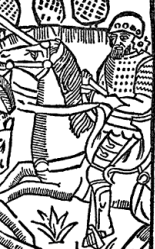The Cavalry

Flodden had been the last ‘bow and bill’ battle for the English. The only contingent of horse on the field was the 200 border horse commanded by Lord Dacre. By the time of Pinkie, the English man at arms had returned to the saddle, all be it supported by German mercenaries. Even so these numbers were woefully inadequate compared to the continental armies of the time. The Scots however had no cavalry at all at Flodden having dismounted their border horse and placed them in to the pike blocks and very few in a fit state to fight at Pinkie after a brush with the English the previous night. However Pitscottie makes a surprising reference when discussing Lennox’s troops mustering in Stirling for the battle of Linlithgow Bridge;
‘and the maister of Kilmaures mett him with tuo thousand horsemen and tuik his [Lennox’s] vangaird in hand and cam forwardis.
It would have made perfectly good tactical sense for these mounted men to stay with their master and act as a reconnaissance force ahead of the army’s advance. However there is little other reference so one can assume that due to the marshy conditions across the river they either dismounted to fight on foot or played no further part in the battle as a cavalry arm. But what type of cavalry were they?
Scottish cavalry of the 16th Century is somewhat of an enigma. The heavy cavalry that was still being used on the continent simply did not exist in the North. The Scottish laird had little need and less inclination to keep a costly war horse or train for combat on horseback. Those that did take their horses to war dismounted to fight. The Earl of Angus notably addressed his force from horseback at Melrose before dismounting for the attack and of course James IV chose to dismount and fight amongst his pike blocks at Flodden. Even as late as Pinkie the Scottish nobles dismounted to fight; Earl of Arran having to call for his horse to be brought to him in order to be the first to flee the field.
However the light horse arm was very impressive and was made up primarily of border horsemen. The tough Reivers were used to fighting their battles from the saddle and were not adverse to riding 40 miles a day before launching a raid at night. The Border horse were somewhat fickle in their loyalty, often feigning the fight whilst collaborating with their colleagues on the other side. Despite their dubious loyalties Border horsemen were found in many of the European armies throughout the early 16th Century and used for reconnaissance, raiding and 'pricking' ie skirmishing on the flanks of the oppositions columns. Most likely the horse mentioned in the accounts for Linlithgow were light horsemen from the West Marches.

